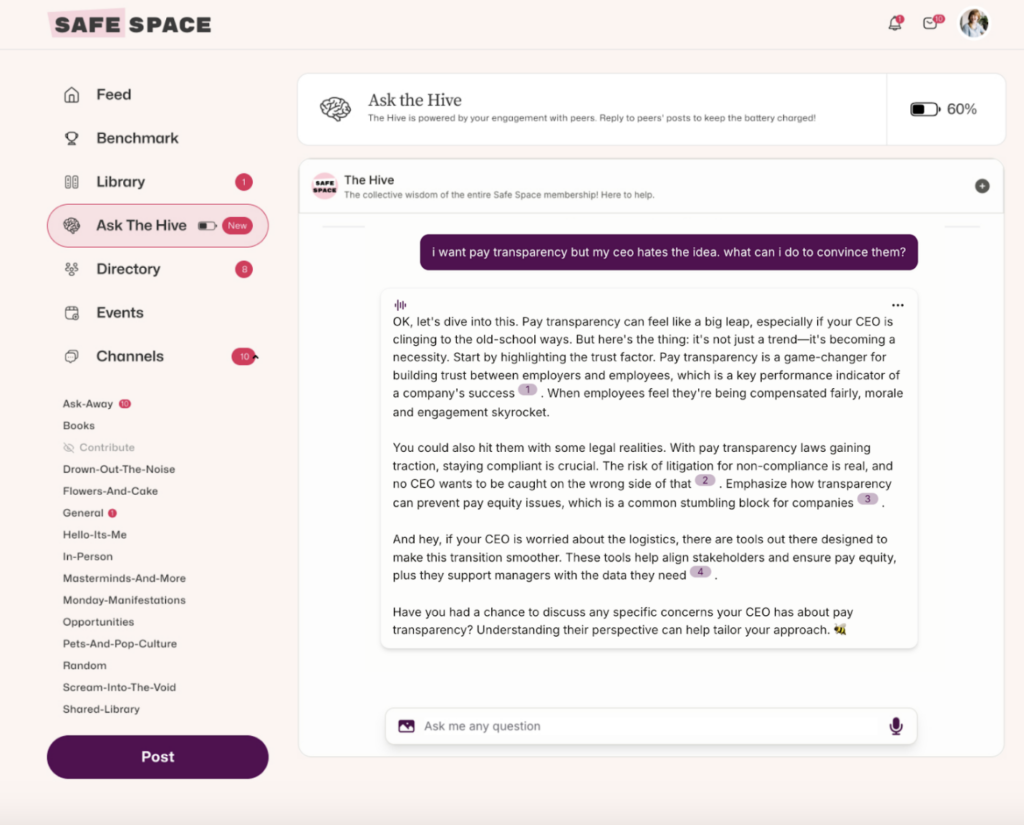
We ask a lot of managers.
Like:
✅Deliver results
✅Motivate their team
✅Retain top performers
✅Drive team performance
✅Coach with empathy and understanding
✅Handle change management
✅Communicate clearly (and constantly!)
✅Foster inclusion
✅Hold people accountable
✅Manage up, down and across
Sometimes all in ONE DAY.
Ooof.
It can be really overwhelming to be a manager.
So, it’s no surprise that manager engagement is at its lowest point in a decade.
JOIN 150K+ HR LEADERS
Get insights, learnings, and advice on how to build companies and cultures that people actually love.
No spam. Unsubscribe any time.
🚨Sound the alarm: Gallup reports that only 31% of managers feel engaged at work, and their burnout is rising faster than any other group.
Managers have one of the biggest impacts on employee engagement so why are leaving them under-resourced and overwhelmed???
We have to stop assuming they’ll “figure it out” and start building real support systems around them.
So, what can HR do about this?
I asked someone I deeply admire, Jill Felska, to share her take on what manager support should actually look like in 2025.
😎Who is Jill? Jill is on a mission to help create a happier, more engaged workforce. She’s the founder of Want To Work There, an online resource hub that provides practical, actionable tools and advice for those who are trying to build better workplace cultures.
This includes the resource she so desperately wanted in her last head of people role – a comprehensive, interactive curriculum and toolkit for modern managers that organizations purchase once and then use to internally train all current and future managers.
❤️ She’s been a day 1 supporter and active member of Safe Space!
👇 Here’s what she had to say:
Meet Jill:

👋🏽 Hi, Jill here.
::insert movie voiceover:: Yup – that’s me. And yes, my hair is always that colorful. 🌈
I’ve spent the last 16+ years of my career obsessed with how we build better workplace cultures. And no, I’m not talking about helping people make the “best places to work” lists.
I’m talking about breaking down the real tactical, actionable decisions and beliefs that shape work as we know it. About challenging the way things are done and what new paths forward can look like in practice.
Over those 16+ years, I’ve been the founder of multiple companies, the head of people for an insurtech startup, a consultant, podcast host, newsletter writer, and so much more.
That said, the one speciality I NEVER, EVER thought I’d have was management training.
If you told me five years ago that it would be my biggest area of passion and focus today, I would have told you you were nuts.
And yet, in my quest to build better workplaces, every road has eventually brought me back to one specific place – people management. Why? Because no one impacts an individual’s experience at work more than their direct manager.
Let’s be honest – there’s a reason the phrase, “People don’t quit jobs, they quit managers” exists.
And yet, we so often promote highly skilled individual contributors and then give them exactly ZERO training, guidance, or support for a role that requires a whole new skillset.
In short, it comes down to exactly what Hebba shared last week. More often than not, we don’t set people managers up for success – and then we’re frustrated when they don’t meet our (unstated) expectations.
How we’re doing our managers so wrong:

So where exactly are we dropping the ball?
Here are three biggest things I believe organizations get wrong when it comes to supporting their people managers:
👎🏼 We don’t define what great people management actually looks like.
I’m going to guess that you’ve gotten at least one complaint about bad management at some point in your career. The problem is, what does bad actually look like?
Could you explain the difference between good and bad people management at your company? And I don’t mean a list of what you personally deem as bad or good. I’m talking about documented company guidelines.
I’ve asked dozens of people this question – and it’s incredibly rare that someone actually can.
And when you really think about it, that’s odd. We define competencies or success metrics for every other role in the company. Why not people management?
At the end of the day, you can’t expect managers to live up to expectations that don’t exist.
👎🏼 We don’t give managers time to actually – you know – manage.
I’ve spent the majority of my career in the startup space where a promotion to people management commonly comes with a title change and (sometimes) a raise – but usually doesn’t include shedding the majority of your individual contributor responsibilities.
Suddenly, you’re still doing your full-time job AND are responsible for leading a team, some of whom were likely your peers pre-promotion. 😅No sweat. Everything is fine. Really.
We forget that “manager” isn’t just a job title that designates hierarchy – it’s a set of responsibilities that must be upheld. Things like holding 1:1 meetings, providing meaningful feedback, aligning team goals with the larger company vision, and delegating work are often not accounted for when it comes to assessing a people manager’s workload – to the great detriment of both the manager and their direct reports.
👎🏼 We don’t provide training support – and when we do, it’s often dated or theory heavy.
Now don’t get me wrong. Theory has a place. But too often managers sit through a lengthy training session – and then leave with absolutely no idea how that knowledge translates to real interactions with their team come Monday morning. Nice that they got the information, but a complete failure when it comes to actually driving behavior change.
We already know that time is a hot commodity. That’s why bridging the gap between the what and the how is absolutely essential when it comes to providing training and support that managers feel was actually worth the investment.
And when it comes to adult learning, gaining buy-in from participants is more than half the battle.🚩Who gets your red flag?
Practical, actionable ways we can do better:

You didn’t think I was going to lay out the problems and then not leave you with some solutions, did you? I would never!
Here are proven, accessible ways you can start building support for your people managers in each of the areas I outlined above.
✅ Set clear expectations – and then communicate them to managers.
Whether it’s a list of the tactical expectations you have for your people managers (like weekly 1:1 sessions, annual performance reviews, etc) or a list of core competencies (like these) that they need to uphold, start moving towards more documented clarity.
Not sure where to start? Our free Manager Expectations Matrix will walk you step by step through defining these exact areas, including both what’s already known and what you’d like to establish moving forward.
And no, it doesn’t need to be perfect!
Your people manager expectations can absolutely evolve as the company does. Please don’t let a desire for perfection stop you from moving forward with this step. Some clarity is always better than no clarity at all – and it opens the door for thoughtful future ideas and discussion!
✅ Follow the 10% rule when it comes to time allocation.
This one is going to be hard to swallow – but stick with me. I promise it’s worth it!
In my work researching, developing, and scaling excellent people management for growing teams, I’ve developed a guideline I refer to as The 10% Rule.
The 10% Rule elicits that (in the modern workplace) at least 10% of a manager’s time per direct report should be allocated to people management responsibilities.
Yes, I said 10% PER direct report.
That means…
- If they manage three people, 30% of their time should be delegated to management.
- Five people? 50%
- Seven? 70%
You get the idea.
Not only does The 10% Rule make time for all those responsibilities you just outlined in the step above, it also helps solve that pesky, “how many direct reports is too many direct reports?” question that seems to pop up often.
Hint: the answer is seven or mayyyyybe eight max.
✅ Lean into providing practical, actionable training, tools, and resources.
Over 300 of you responded to Hebba’s management survey! The results are in and the top three skills your managers currently are missing are coaching for growth, setting expectations and giving feedback. There’s no question that each plays a critical role in great people management!
So how do you go about teaching those skills?
The truth is, there are a lot of different ways you can approach management training. While I’m biased to our Training for the Modern Manager program (because, obviously), there are a ton of great options out there, each with their own unique strengths.
In my experience, there are a couple things you’ll want to keep top of mind when designing or selecting the right support for your people managers – each grounded in adult learning theory:
✔️ Does the training bridge the what to the how? Like I said earlier, theory is great – but what we’re aiming for is comprehension and behavior change. The most effective experiences introduce theory in digestible amounts, providing just enough context and understanding for the practical applications that follow.
✔️ What on-going tools and resources will managers have access to? Content that can be immediately applied to solve real problems or improve performance will always be the most engaging – but (sadly) you’ll never hit that sweet spot with every participant the first time around. Make sure that the training you provide is easily accessible for reference following the program. I personally love scenario-based prompts (such as “I’ve been giving clear, actionable feedback, but nothing is changing”) that bridge managers directly back to the related content and tools. It’s easy and very effective.
✔️ Is there a cohort-based aspect to the program? Together really is just better. Again and again, I’ve witnessed the power of cohort-style learning. Not only does it build and strengthen relationships across teams (silo-busting anyone?), it creates a shared sense of commitment that doesn’t exist with self-paced individual learning. Knowing others are counting on your participation and contribution creates natural motivation to stay engaged and complete the work.
No matter what type of training or support you land on, make sure to center the manager and communicate early and often the positive impacts that participating will have on their personal experience at work!
Making the case internally:

Hopefully, I’ve sold you on the power of providing all kinds of support for your people managers. Which – yay! But it’s likely you’ll need to get others on-board before you roll out these changes. A frustrating reality I have a strong sense you’re passionately familiar with.
I’ve been there. I get it.
Here’s some fuel to get you started when you want to make the case…
💪 For developing manager core competencies and expectations.
There’s nothing like the power of a good story. And when it comes to helping others really see the benefit of management competencies, there’s no better story than Google’s Project Oxygen.
In 2002, Google founders Larry Page and Sergey Brin made the radical decision to completely eliminate all engineering management roles – claiming management was at best an “unneeded bureaucratic oversight.”
Spoiler alert: it didn’t go well.
Within months, the managers were reinstated, but Larry and Sergey still weren’t convinced. They launched a giant research initiative (now known as Project Oxygen) in an effort to finally prove that managers weren’t needed.
Rather than confirming the engineers’ belief that managers were unnecessary, the data clearly showed that good managers had a significant positive impact on team performance, employee satisfaction, and retention – and resulted in Google’s 10 key behaviors of effective managers.
Whether you develop your own behavioral competencies or (with their full blessing) steal theirs, you’ve got yourself a compelling case for even the most analytical minded thinkers.
⏱️ For allotting more time for people management.
Remember that Manager Expectations Matrix you made a copy of earlier? That data is going to be your best friend when it comes to driving this initiative.
I’ve found that it’s best to gain buy-in and alignment (whether from the CEO or an entire leadership team) on what expectations and competencies need to exist in order for your people managers to succeed. Only then do you come in hot with the reality that those things take time.
It’s hard to argue with The 10% Rule when everyone in the room has just made compelling cases for the very expectations you’re advocating time to accomplish.
💸 For investing in training and development support.
There are lots of reasons to invest in management training, but we all know that many decisions ultimately come down to the bottom line. Here are two data driven approaches to making the case that will help even the most financially-minded members of your team see that what you’re proposing is not an expense, but rather an investment – one with a strong ROI.
➡️ Employee Retention and Recruitment Costs This is the big one. Whether you decide to use high-level stats about just how expensive replacing and retraining new employees is or provide direct data from your own organization, there is no larger financial motivator than retaining the exceptional talent you already have.
➡️ Direct Impact on the Bottom Line In 2023, McKinsey released their findings on the correlation between strong management and company profits – notably that “organizations with top-performing managers yield multiple times the total shareholder returns (TSR) of those with average or below-average managers over a period of five years.” In other words, exceptional managers quite literally translate to more business revenue. Hard to argue with that, right?
I truly hope this edition on supporting modern people managers has provided both a strong dose of inspiration and some tactical knowledge to put it to use. And, if that’s not now (because hello two-million competing priorities) I hope it finds you again at the right time.
For now, I’ll leave all of you beautiful, passionate humans with the same message I used to share at the end of every podcast episode…
I see you. I believe in you. And keep going. The work you’re doing really matters.
What’s next:

Next week, we’re taking a brief break from talking about what employees want.
And instead I’m sharing some juicy manager horror stories!
Have one to submit?




